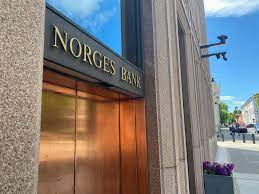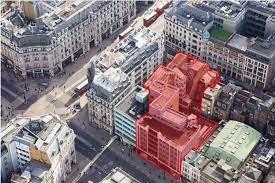Norway’s US$1.6 trillion fund turns developer on trophy UK properties

London: Norway’s US$1.6 trillion sovereign wealth fund kicked off a glitzy property-buying spree in London more than a decade ago. Now it’s trying to figure out ways to keep the shine on some of those increasingly tired trophy buildings.
For starters, Norges Bank Investment Management (NBIM) is dipping its toe into development projects as it prepares for a series of key lease expiries across its UK portfolio.
The fund has already taken back a part of Bank of America Corp’s London office campus for a comprehensive overhaul. That could be a precursor to answering the far larger question of what happens if the lender chooses to vacate altogether when its main lease runs out in 2032.

“It’s providing valuable insight and research for us,” Michael Carter, a senior asset manager at NBIM said in an interview. “We’re getting down to the bones of that building, which was constructed in the same form as the main Bank of America building.”
It’s a phenomenon that’s playing out across London. First Brexit, then the pandemic and now higher interest rates – all these events have disrupted the plans of premium real estate investors. Overseas funds with few people on the ground are being forced to contemplate complex redevelopments of buildings, some of which they had expected to sell long before their leases ran down, reducing their value.
Like many sovereign investors with large cheque books and small real estate teams, NBIM initially targeted either joint ventures with established players or premium buildings with long leases to top tenants. Those low risk buildings typically require little management, allowing funds without a real estate track record to scale large portfolios without having to employ hundreds of asset managers.
But a decade on from NBIM’s acquisition, the lease on BofA’s London campus has about eight years left and is edging toward the point at which such a large occupier must contemplate whether to stay or go given the scarcity of alternative buildings big enough to accommodate it.
The fund had weighed a sale of the building but halted the process in the summer of 2022 after Russia’s invasion of Ukraine and rising interest rates upended the commercial real estate market.
“It was an opportunity where we thought if we could sell it at a certain price, we’d be better off deploying the capital elsewhere,” Carter said. “Actually things had transpired to move against us. We said that’s fine. We were always happy to own the property, keep it and work through the business plan and maintain it for a period.”
Other funds are confronting similar challenges.
The Qatar Investment Authority faces the prospect of both Credit Suisse and HSBC Holdings vacating their respective Canary Wharf headquarters. Malaysia’s Permodalan Nasional is overhauling the former European Bank of Redevelopment and Construction building at 175 Broadgate. It also owns One Silk Street, which will require a substantial upgrade after law firm Linklaters soon vacates the premises.
NBIM operates under a strict investment mandate laid out by the government, which allows for a maximum 7 per cent in unlisted real estate. As of end-March, only about 2 per cent of investments were in unlisted property holdings globally, totalling US$28.5 billion, according to a recent filing. About a third are in partnerships, with the rest in wholly owned properties, Carter said.
BofA isn’t the only key tenant in NBIM’s London portfolio with an approaching lease expiry. Amazon.com’s agreement at the nearby Sixty London is currently scheduled to end in 2028.
While that building is much newer than the BofA campus, there’s no certainty that Amazon will renew. And the pace of change in an office market that’s been upended by the pandemic and growing environmental demands means even relatively young buildings can still need substantial work to attract tenants should the company opt not to renew.
At 20 Giltspur Street – the space already vacated by BofA – the fund is experimenting with techniques designed to reduce the carbon footprint of the project, including lifting entire floors in an effort to reuse the steel frame while creating additional space. It’s among the first significant development projects undertaken directly by NBIM in the UK since it signed its debut real estate deal in the city in early 2011, buying a 25 per cent stake in a 150-year lease on The Crown Estate’s Regent Street properties.
The project, which was approved in October 2022, includes adding about 25,000 square feet to create a lettable property just under 90,000 square feet. The space available for rent at the Bank of America Merrill Lynch Financial Centre at 2 King Edward Street spans about 500,000 square feet.
ESG is “one of the fastest moving areas of building technology and specifications,” Carter said, adding that work in London parallels what the fund is doing in Paris, where it owns buildings up and down the Champs-Elysees.
“There’s obviously a lot of pressure across London,” he added. “There’s a lot more pressure to reuse rather than replace.”
NBIM, which was established in the 1990s to invest in Norway’s oil riches, has since added assets along Oxford Street, as well as in Mayfair and in the city’s financial district. Holdings today amount to about US$5.6 billion in unlisted real estate in the UK alone.
“We’ve been looking to invest more in London since 2019, but haven’t really seen the right opportunities at the right pricing,” said Matthew Fellows, a senior investment manager at NBIM’s UK real estate team. “I’m somewhere in between hoping and expecting to buy more this year.”
The fund’s most recent UK purchase was in October 2022, when it bought a 49 per cent stake in a life sciences property in Cambridge for £90.2 million (S$152 billion).
There has been a natural shift from being a passive owner of long-income properties to becoming an active manager, Carter said.
“We have the equity to invest in our assets and have always wanted to be a proactive, hands-on investor,” he added.





